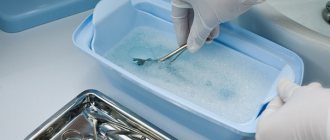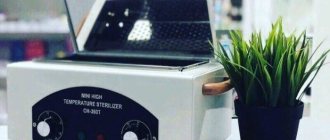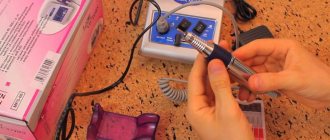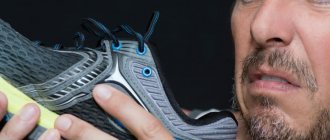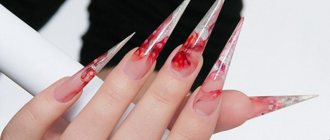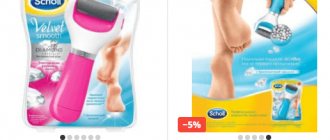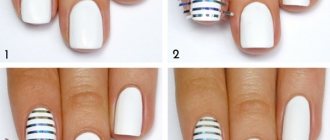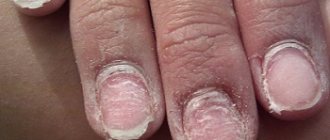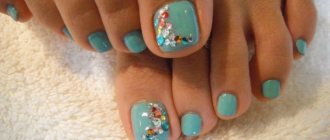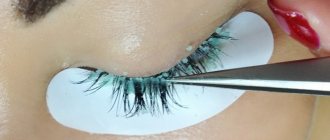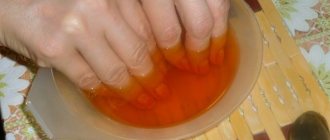Features and nuances of file disinfection
Disinfection is a process during which the surface of manicure instruments (files, scissors, buffs, cutters) is disinfected. Using special means, pathogens that can cause infection to the client are destroyed.
Disinfection does not completely eliminate bacteria - about 30% of pathogens still remain on the surface of manicure devices. In this regard, the second stage of processing is carried out - sterilization.
It is necessary to disinfect all instruments in contact with the skin after each client. When the mandatory manipulations to destroy bacteria are completed, files and buffs must be stored in conditions that prevent their re-infection. For this purpose, a bactericidal ultraviolet cabinet is used.
The manicure room must be equipped with a recirculator - a closed device designed for air disinfection. In practice, it is extremely rare to find such bactericidal irradiators among nail service professionals.
Sterilization of manicure instruments with alcohol
The use of alcohol and alcohol solutions to sterilize manicure instruments is only permissible when they are for home use and the woman works with them alone. Even under this condition, the instrument must be boiled in distilled water once a month. Then you will not be afraid of fungi and other diseases.
If the instrument is used in a beauty salon, then sterilization with alcohol will be insufficient and the possibility of infection will be high. In this case, it is necessary to use additional devices and instruments: an oven, an ultrasonic sterilizer, etc.
How to disinfect files and buffs
An important feature of the first stage of disinfection of files and buffs is that they must be placed in a special solution immediately after use. If the materials have been in contact with the environment for some time, dirt and skin particles on the instruments harden, and the disinfectant liquid helps them adhere to the surface.
Important! It is prohibited to rinse the instrument before disinfection - bacteria, viruses, and other pathological microorganisms can be spread throughout the sink and nearby objects.
Solutions for the destruction of microorganisms are sold both ready-to-use and in the form of concentrates that must be diluted with water. The instructions describe the conditions for using the liquid and the time required for disinfection.
For the disinfector, you must purchase a special container made of material that is resistant to chemicals.
Warning! As soon as a precipitate appears in the solution or the liquid becomes cloudy, the concentrate must be changed without waiting for the expiration date.
How to Sterilize Nail Files with Dry Heat
When the process of disinfection of nail files and other tools is completed, you need to move on to the second stage of treatment. It is necessary to sterilize manicure devices: this is the only way to achieve complete destruction of pathogens.
There are two types of sterilization of nail files:
- Chemical – using artificially synthesized substances in the form of solutions. You can sterilize materials with some of the same liquids that are used to disinfect, but in higher concentrations.
- Thermal – exposure to high temperatures.
To completely remove all pathogenic organisms, it is recommended to sterilize thermally. This method involves the use of the following types of devices:
- Sterilizer with glassperlene beads heated to ultra-high temperatures. This type of device is the most budget-friendly; its significant drawback is that files and scissors become dull when in contact with the balls.
- Autoclave. It does not melt parts of instruments made of rubber (unlike other types of sterilizers), killing bacteria with its help is the most effective method. The disadvantage of an autoclave is its high cost.
- Dry heat cabinet. The most preferred sterilizer in terms of price/quality ratio.
As the most popular sterilizer, dry heat is used in many salons and by craftsmen working at home. Manicure accessories must be placed in it exclusively dry.
Algorithm for working with a dry heat sterilizer:
- The instruments are disinfected, then thoroughly washed with brushes under running water and dried.
- The cabinet warms up to 180 degrees Celsius.
- Files, cutters, scissors are sealed in disposable paper bags, which will be opened in front of the client, or simply laid out on dry-heat shelves.
- After closing the cabinet, the instruments remain there for 30 minutes, then the sterilizer is turned off.
How to process manicure files in sterilization devices
Before putting the files into the sterilizer, they must be cleaned of visible dirt. This is done by washing the devices under running water with a stiff brush.
Important! You can’t save time on washing your files. To remove skin, blood, and dirt from them, it takes at least 30–60 seconds for each device.
Each type of sterilizer has its own processing characteristics for saw files:
- Instruments are placed in the autoclave wet, placing them in craft bags or laying them out on shelves without them. The destruction of bacteria occurs under high pressure at a temperature not exceeding 135 degrees. Files are sterilized in such a device for up to 15 minutes;
- sterilizer with glassperlene beads. Files and other tools must be placed in it dry, otherwise rust will form on the surface. The working part of the devices is placed in the sterilizer for 30 seconds;
- the features of using a dry heat sterilizer were described above.
How to disinfect nail files with antiseptic agents
Before placing the files in the sterilizer, they must be treated with antiseptic agents (Lysoformin 3000).
Sources containing instructions regarding the disinfection of manicure devices speak of two types of primary destruction of pathogens: intermediate and high level disinfection. The first type involves eliminating bacteria on files used when working with intact skin. A high level implies more thorough processing of instruments that have been in contact with damaged skin.
In addition to solutions, there are antiseptics in sprays (for example, Deskosept AF). Their use is an express method that provides a secondary effect.
Disinfection and sterilization
Today, with the development of the nail industry, salons and professionals working at home provide a wide range of services to clients. In order for manicure procedures to be performed at the highest level, special attention should be paid not only to the quality of the work performed, but also to the safety of its implementation. Compliance with anti-epidemic, disinfection, and sterilization regimes is the basis of safe services.
Any actions that may lead to damage to the skin and mucous membranes must be carried out using sterile instruments and materials. Every master who values his clients should remember this.
There are three processing stages:
disinfection, pre-sterilization cleaning and sterilization.
Disinfection
- This is a mandatory first stage of any processing. During the disinfection process, viruses, pathogens, bacteria and fungi are destroyed.
All surfaces of the master’s workplace and tools, as well as the hands of the master and the client, are subject to mandatory disinfection. For nail services, it is suitable to use steam and air sterilizers (ultrasonic sterilizers), as well as a chemical disinfection method using special agents with antiviral and antifungal effects. To disinfect the air, you should use a bactericidal ultraviolet irradiator. Quartzing must be carried out after each wet cleaning of the room for 20 minutes, then the room should be ventilated.
The procedure for disinfecting instruments:
1. Immediately after use, the instrument is immersed in a disinfectant solution. Cleaning from primary contaminants is carried out using brass brushes or cotton-gauze swabs.
2. The instrument is immersed in another, clean container with a disinfectant solution. The liquid should completely cover the instruments.
3. After soaking in the solution (the time is prescribed in the instructions for the drug), the instruments are washed with running water for 5 minutes.
It is important to know!
Work is performed only with protective gloves. If traces of rust are detected, the tool becomes unsuitable for use with clients. Do not rinse tools with water immediately after use; there may be a risk of infection of surrounding surfaces, clothing and hands of the master.
The next stage is pre-sterilization cleaning
. Cleaning is carried out to remove protein, fat and mechanical contaminants, as well as drug residues, from products. The procedure is carried out manually (using chemicals) or using special equipment.
The last and most important stage is sterilization
. In this process, all viable microorganisms, including resistant ones, and their spore forms are completely destroyed. Some varieties of spores can withstand boiling and strong disinfectants. Everything that came into contact with the client’s skin and nails is sterilized. To perform the sterilization procedure, the following types of devices are used: a dry-heat oven, an autoclave or a quartz ball sterilizer. They differ in the type of impact. In a dry-heat oven, sterilization is carried out using hot air (180-200 C), in an autoclave, steam sterilization is carried out, and in a quartz ball sterilizer, an air method is used to heat quartz balls.
It is important to know!
Only dried instruments are subject to sterilization, if possible disassembled or opened. Ultraviolet light does not kill viral forms such as hepatitis and HIV. UV sterilizers can only be used for storing already sterile, dry instruments!
Care and storage
Once all processing steps have been completed, instruments should be stored in an appropriate sterile environment. A UV sterilizer or sterile disposable bags work well for this. Under such conditions, the instruments remain sterile for 3 days. It is necessary to regularly replace the lamps in the sterilizer; with increasing service life, they lose their radiation power, and the ability to disinfect the air decreases.
Rules for disinfecting nail files at home
Processing nail files at home is no different from the salon, with the exception that this process cannot be controlled by sanitary authorities, and it depends only on the conscientiousness of the master.
At home, files must undergo the same disinfection steps:
- Disinfection.
- Rinse with brushes under running water.
- Sterilization in a special device.
If at least one of the points is not met, the master exposes clients to the risk of infection with bacterial, viral, and fungal diseases.
Disinfection in salon conditions
There should be a container with a disinfectant solution near each worker’s workplace. It indicates the name of the drug, expiration date and required concentration. Depending on the concentration, the master dilutes the substance according to the instructions and immerses the used instrument in it. The disinfection time must be indicated in the instructions for each drug.
After disinfection is completed, the nail files are removed from the disinfectant solution and thoroughly washed with water. Then they are dried and put away in a clean place (special box for storing tools).
This is a standard disinfection scheme for manicure files. But it may not be applicable to a specific instrument. Therefore, some restrictions on disinfection procedures should be considered:
- Paper-based files should not be immersed in any liquid. Whether it is alcohol or any other disinfectant, a tool of this type will become limp and become unsuitable for work. Therefore, when using such files at home, they are not soaked in the solution, but treated with a spray. In beauty salons, such files cannot be reused. They must be destroyed immediately after completing the manicure.
- Wood files are also very afraid of any liquids. They swell greatly from prolonged contact with solutions. Therefore, they are also not recommended for beauty salons. After all, you will not be able to perform thorough processing. It is better to leave these files for home procedures.
- Electronic or laser files are not subject to routine disinfection. When working with them, you must adhere to the recommendations set out in the instructions for the tool.
